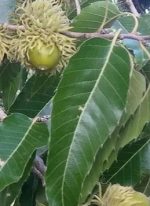 Sawtooth oak is a medium sized deciduous tree growing up to 98” tall. It is native to northeastern India, Nepal, Bhutan, Indochina, China, Tibet, Korea, and Japan and was introduced into eastern North America in about 1920 to provide food for wildlife and has naturalized in the mid Atlantic region southwest to Louisiana. The acorns, however, are bitter and not successful as wildlife food but together with the rapid growth rate of the tree have facilitated their spread in the Mid Atlantic states, south along the coast to Louisiana, excluding Florida. USDA Hardiness zones 6-9
Sawtooth oak is a medium sized deciduous tree growing up to 98” tall. It is native to northeastern India, Nepal, Bhutan, Indochina, China, Tibet, Korea, and Japan and was introduced into eastern North America in about 1920 to provide food for wildlife and has naturalized in the mid Atlantic region southwest to Louisiana. The acorns, however, are bitter and not successful as wildlife food but together with the rapid growth rate of the tree have facilitated their spread in the Mid Atlantic states, south along the coast to Louisiana, excluding Florida. USDA Hardiness zones 6-9
The following natives are recommended as alternatives:
Shingle Oak (Quercus imbricaria)
This deciduous tree grows up to 60’ tall and has glossy green, laurel-like leaves and an attractive pyramidal form. It is native to upland forests and wooded slopes from Pennsylvania to Minnesota, south to North Carolina and Kansas. USDA Hardiness Zones 4-8
Chinquapin Oak (Quercus muehlenbergii)
Native to dry upland sites often in rocky alkaline soils in eastern and central North America from Vermont west to Wisconsin and south to South Carolina, western Florida, and New Mexico, Chinquapin Oak grows up to 60’ high and has sweet acorns that are an excellent food source for wildlife as well as people. USDA Hardiness Zones 5-7
Water Oak (Quercus nigra)
Water oak is a medium sized tree growing up to 80’ tall and is native to wet, swampy areas as well as well-drained sites in southeastern US from New Jersey to Florida and Texas, northward along theMississippi valley to western Kentucky, southern Illinois and the Missouri bootheel. The leaves often fall late and may persist into winter. Acorns are an important food for birds and large and small mammals including whit-tail deer. USDA Hardiness Zones 6-9
Willow Oak (Quercus phellos)
A popular landscape tree because of its rapid growth shade tolerance, and light green canopy, this deciduous tree is native to lowland floodplains and along streams in eastern and central US from Long Island south to northern Florida and west to southernmost Illinois, Missouri, Oklahoma and eastern Texas. It’s abundance of acorns provide food for birds and other wildlife but its leaves can be a chore to rake out of grass in the fall if planted as a lawn tree. USDA Hardiness Zones 5-9
Green Ash (Fraxinus pennsylvanica)
Growing up to 70’ tall, green ash is a deciduous tree native to lowlands where it grows on floodplains and along streams and ponds from Nova Scotia to Alberta south to Florida and Texas. The foliage may provide attractive color in fall. USDA Hardiness Zones 3-9